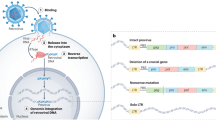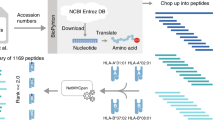Abstract
Human endogenous retrovirus sequences (HERVs) reside in the genomes of primates and humans for several million years. The majority of HERVs is non-coding but a limited set is intact and can express proteins. We have recently identified an almost intact HERV-K(HML-2) provirus on chromosome 7 and have documented that most patients with germ cell tumors (GCTs) display antibodies directed against proteins of HERV-K(HML-2). To address whether these proteins merely represent tumor markers or contribute to neoplastic transformation, we examined the transforming potential of various HERV sequences and studied physical interactions between HERV and cellular proteins by yeast two-hybrid and biochemical assays. cORF, a protein encoded by the C-terminal open reading frame within the env gene, supports tumor growth in nude mice and associates with the promyelocytic leukemia zinc finger protein (PLZF). The interaction domains map between amino acid residues 21 and 87 of cORF, and between residues 245 and 543 of PLZF. PLZF is critical for spermatogenesis in mice. Abnormal spermatogenesis or maturation of gonocytes is thought to predispose humans to the development of germ cell tumors. Thus, cORF of human endogenous retroviruses may contribute to tumor development by interfering with processes during spermatogenesis that involve PLZF.
This is a preview of subscription content, access via your institution
Access options
Subscribe to this journal
Receive 50 print issues and online access
$259.00 per year
only $5.18 per issue
Buy this article
- Purchase on Springer Link
- Instant access to full article PDF
Prices may be subject to local taxes which are calculated during checkout






Similar content being viewed by others
References
Arnould C, Philippe C, Bourdon V, Goire MJ, Berger R and Jonveaux P. . 1999 Hum. Mol. Genet. 8: 1741–1749.
Barna M, Hawe N, Niswander L and Pandolfi PP. . 2000 Nat. Genet. 25: 166–172.
Boese A, Sauter M and Mueller-Lantzsch N. . 2000 FEBS Lett. 468: 65–67.
Chen SJ, Zelent A, Tong JH, Yu HQ, Wang ZY, Derre J, Berger R, Waxman S and Chen Z. . 1993a J. Clin. Invest 91: 2260–2267.
Chen Z, Brand NJ, Chen A, Chen SJ, Tong JH, Wang ZY, Waxman S and Zelent A. . 1993b EMBO J. 12: 1161–1167.
David G, Alland L, Hong SH, Wong CW, DePinho RA and Dejean A. . 1998 Oncogene 16: 2549–2556.
de The H, Chomienne C, Lanotte M, Degos L and Dejean A. . 1990 Nature 347: 558–561.
Grignani F, De Matteis S, Nervi C, Tomassoni L, Gelmetti V, Cioce M, Fanelli M, Ruthardt M, Ferrara FF, Zamir I, Seiser C, Grignani F, Lazar MA, Minucci S and Pelicci PG. . 1998 Nature 391: 815–818.
Guidez F, Huang W, Tong JH, Dubois C, Balitrand N, Waxman S, Michaux JL, Martiat P, Degos L and Chen Z. . 1994 Leukemia 8: 312–317.
Hawe N, Soares V, Niswander L, Cattoretti G and Pandolfi P. . 1996 Blood 88: (abstr. supp 1) 291a.
He LZ, Guidez F, Tribioli C, Peruzzi D, Ruthardt M, Zelent A and Pandolfi PP. . 1998 Nat. Genet. 18: 126–135.
Heimdal K, Olsson H, Tretli S, Fossa SD, Borresen AL and Bishop DT. . 1997 Br. J. Cancer 75: 1084–1087.
Herbst H, Sauter M, Kuhler-Obbarius C, Loning T and Mueller-Lantzsch N. . 1998 APMIS 106: 216–220.
Herbst H, Sauter M and Mueller-Lantzsch N. . 1996 Am. J. Pathol. 149: 1727–1735.
Hong SH, David G, Wong CW, Dejean A and Privalsky ML. . 1997 Proc. Natl. Acad. Sci. U.S.A 94: 9028–9033.
Hyman J, Chen H, Di Fiore PP, De Camilli P and Brunger AT. . 2000 J. Cell Biol. 149: 537–546.
Koken MH, Daniel MT, Gianni M, Zelent A, Licht J, Buzyn A, Minard P, Degos L, Varet B and de The H. . 1999 Oncogene 18: 1113–1118.
Koken MH, Reid A, Quignon F, Chelbi-Alix MK, Davies JM, Kabarowski JH, Zhu J, Dong S, Chen S, Chen Z, Tan CC, Licht J, Waxman S, de The H and Zelent A. . 1997 Proc. Natl. Acad. Sci. USA 94: 10255–10260.
Li JY, English MA, Ball HJ, Yeyati PL, Waxman S and Licht JD. . 1997 J. Biol. Chem. 272: 22447–22455.
Lin RJ, Nagy L, Inoue S, Shao W, Miller Jr WH and Evans RM. . 1998 Nature 391: 811–814.
Lower R, Boller K, Hasenmaier B, Korbmacher C, Muller-Lantzsch N, Lower J and Kurth R. . 1993 Proc. Natl. Acad. Sci. USA 90: 4480–4484.
Lower R, Tonjes RR, Korbmacher C, Kurth R and Lower J. . 1995 J. Virol. 69: 141–149.
Magin C, Lower R and Lower J. . 1999 J. Virol. 73: 9496–9507.
Mangeney M and Heidmann T. . 1998 Proc. Natl. Acad. Sci. USA 95: 14920–14925.
Mayer J, Meese E and Mueller-Lantzsch N. . 1997a Cytogenet. Cell Genet. 78: 1–5.
Mayer J, Meese E and Mueller-Lantzsch N. . 1997b Cytogenet. Cell Genet. 79: 157–161.
Mayer J, Sauter M, Racz A, Scherer D, Mueller-Lantzsch N and Meese E. . 1999 Nat. Genet. 21: 257–258.
Melnick A and Licht JD. . 1999 Blood 93: 3167–3215.
Mueller-Lantzsch N, Sauter M, Weiskircher A, Kramer K, Best B, Buck M and Grasser F. . 1993 AIDS Res. Hum. Retroviruses 9: 343–350.
Ravnik SE and Wolgemuth DJ. . 1999 Dev. Biol. 207: 408–418.
Redner RL, Rush EA, Faas S, Rudert WA and Corey SJ. . 1996 Blood 87: 882–886.
Reid A, Gould A, Brand N, Cook M, Strutt P, Li J, Licht J, Waxman S, Krumlauf R and Zelent A. . 1995 Blood 86: 4544–4552.
Sauter M, Roemer K, Best B, Afting M, Schommer S, Seitz G, Hartmann M and Mueller-Lantzsch N. . 1996 Cancer Res. 56: 4362–4365.
Sauter M, Schommer S, Kremmer E, Remberger K, Dolken G, Lemm I, Buck M, Best B, Neumann-Haefelin D and Mueller-Lantzsch N. . 1995 J. Virol. 69: 414–421.
Skakkebaek NE. . 1972 Lancet 2: 516–517.
Skakkebaek NE, Berthelsen JG, Giwercman A and Muller J. . 1987 Int. J. Androl. 10: 19–28.
Wells RA, Catzavelos C and Kamel-Reid S. . 1997 Nat. Genet. 17: 109–113.
Yang J, Bogerd HP, Peng S, Wiegand H, Truant R and Cullen BR. . 1999 Proc. Natl. Acad. Sci. USA 96: 13404–13408.
Yee JK, Friedmann T and Burns JC. . 1994 Methods Cell Biol. 43: 99–112.
Yeyati PL, Shaknovich R, Boterashvili S, Li J, Ball HJ, Waxman S, Nason-Burchenal K, Dmitrovsky E, Zelent A and Licht JD. . 1999 Oncogene 18: 925–934.
Zhang T, Xiong H, Kan LX, Zhang CK, Jiao XF, Fu G, Zhang QH, Lu L, Tong JH, Gu BW, Yu M, Liu JX, Licht J, Waxman S, Zelent A, Chen E and Chen SJ. . 1999 Proc. Natl. Acad. Sci. USA 96: 11422–11427.
Acknowledgements
We are grateful to Roger Brent and Jonathan Licht for materials and to Reinhard Maier and Stefan Theis for help with software application. This work was supported in part by grants from the German Research Foundation (DFG) to K Roemer (SFB399-B5) and N Mueller-Lantzsch (SFB399-B2).
Author information
Authors and Affiliations
Rights and permissions
About this article
Cite this article
Boese, A., Sauter, M., Galli, U. et al. Human endogenous retrovirus protein cORF supports cell transformation and associates with the promyelocytic leukemia zinc finger protein. Oncogene 19, 4328–4336 (2000). https://doi.org/10.1038/sj.onc.1203794
Received:
Revised:
Accepted:
Published:
Issue Date:
DOI: https://doi.org/10.1038/sj.onc.1203794
Keywords
This article is cited by
-
Effect of human endogenous retrovirus-K env gene knockout on proliferation of ovarian cancer cells
Genes & Genomics (2022)
-
A human endogenous retrovirus encoded protease potentially cleaves numerous cellular proteins
Mobile DNA (2019)
-
Transactivation of human endogenous retroviruses by tumor viruses and their functions in virus-associated malignancies
Oncogenesis (2019)
-
Transcriptional profiling of HERV-K(HML-2) in amyotrophic lateral sclerosis and potential implications for expression of HML-2 proteins
Molecular Neurodegeneration (2018)
-
HERV-K(HML-2) rec and np9 transcripts not restricted to disease but present in many normal human tissues
Mobile DNA (2015)



